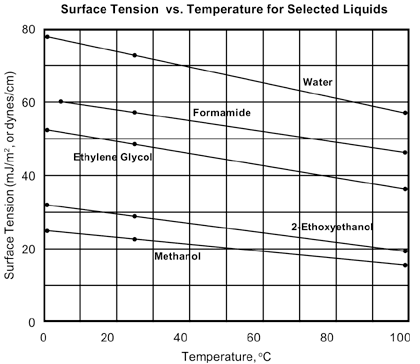DuNouy Tensiometer Test Method
1. Ensure that the instrument is set up and accurately calibrated, in accord with the manufacturer's instructions. It is critical that it is level and stable.
2. Cleanliness of the ring and vessel are both paramount to accurate test results. Clean both appropriately before use (exact cleaning methods will vary, depending on the liquid you are testing); the ring must always be cleaned between tests, even when used repeatedly in the same liquid vessel.
3. Surface tension measurement.
3.1. Attach the ring to the lever arm.
3.2. Fill a vessel such as an evaporating dish, watch glass, or beaker, with a diameter of at least 4.5 cm, to a minimum depth of 1.0 cm. Record the exact temperature of the liquid; surface tension is inversely related to temperature — see the chart below for some examples.
3.3. Place the vessel on the sample table. Raise the sample table assembly until the ring is immersed approximately 5 mm into the liquid. Ensure that the ring is roughly centered in the test vessel. Lower the sample table assembly until the ring is just below the surface of the liquid.
3.4. Using the fine adjustment screw, continue lowering the table until the ring is just within the surface of the liquid, with the index reading still at approximately zero.
3.5 Gradually increase the torsion of the wire while slowly lowering the table; this balance of forces will keep the index reading at zero even as the surface of the liquid is distended by the removal of the ring. Continue this step until the liquid film breaks, and the ring breaks free.
3.6 The scale reading at the breaking point of the liquid film is the force of the pull exerted on the ring, or the apparent surface tension.
4. This apparent surface tension must be adjusted by using a correction factor that accounts for the circumference of the ring, the size of wire used in the ring, and the density of the liquid. Charts, formulas, and computer programs can be used to obtain the appropriate correction factor.
5. Record this adjusted value, along with the exact temperature at which the measurement was performed. A temperature correction factor can be applied, reducing all measurements to a common basis.
